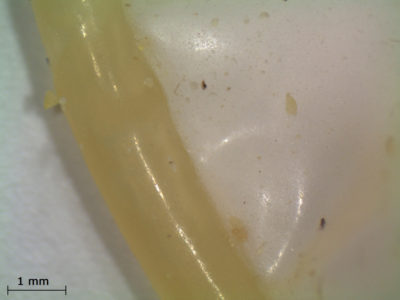Condoms and Lubricants
Intercourse paraphernalia, such as condoms and lubricants, can be the subject of criminal or product tampering/contamination cases. Utilizing our diverse collection of analytical techniques, including light microscopy, infrared microspectroscopy, and GC-MS, Microtrace is uniquely equipped to analyze such samples.
Condoms
Over the years, Microtrace has investigated many complaints from consumers alleging condoms present in a food product (food forensic investigations). While consumers are excellent at recognizing the presence of foreign matter, “identifications” made by consumers and quality assurance departments are often incorrect. Frequently, consumer-identified “condoms” have turned out to be fragments of latex gloves or other similar-looking materials that were introduced to the product at some point. Incorrect or partial assessments can escalate situations, wheres a solid, factual identification provided at an early stage can give all parties the information needed to assess a situation properly. After determining that a foreign object is (or is not) a condom, we can provide further analysis of the item to determine if it was processed with the food product or if it was consumed in any manner. In some projects, we have even conducted experiments to determine how the condom’s appearance and structure would have changed after having been cooked with a food product.
Increasingly, condoms are being used in sexual assaults. In these instances, the condom itself can become central evidence in the case. Most crime laboratories process condoms strictly for the recovery of DNA, but Microtrace is able to characterize any fluids or other trace materials that may be associated with the condom, providing additional assistance to an investigation.
Personal Lubricants
Personal lubricants can also be of importance in sexual assault cases when an unknown liquid is present or when a condom was used. Often these lubricants are initially misidentified as semen, leading to confusion and wasted resources when service laboratories are unable to extract DNA. Personal lubricants are part of a broader class of lubricants that are used in machinery, cars, and even hinges, and are developed from a range of materials, including silicone, polyethylene glycol, water, and petroleum. Using our customized sample-driven approach, Microtrace is able to isolate and analyze unknown liquid samples, including personal lubricants, in a manner tailored to our client’s needs.
How May We Help You?
Contact usto discuss your project in more detail.








